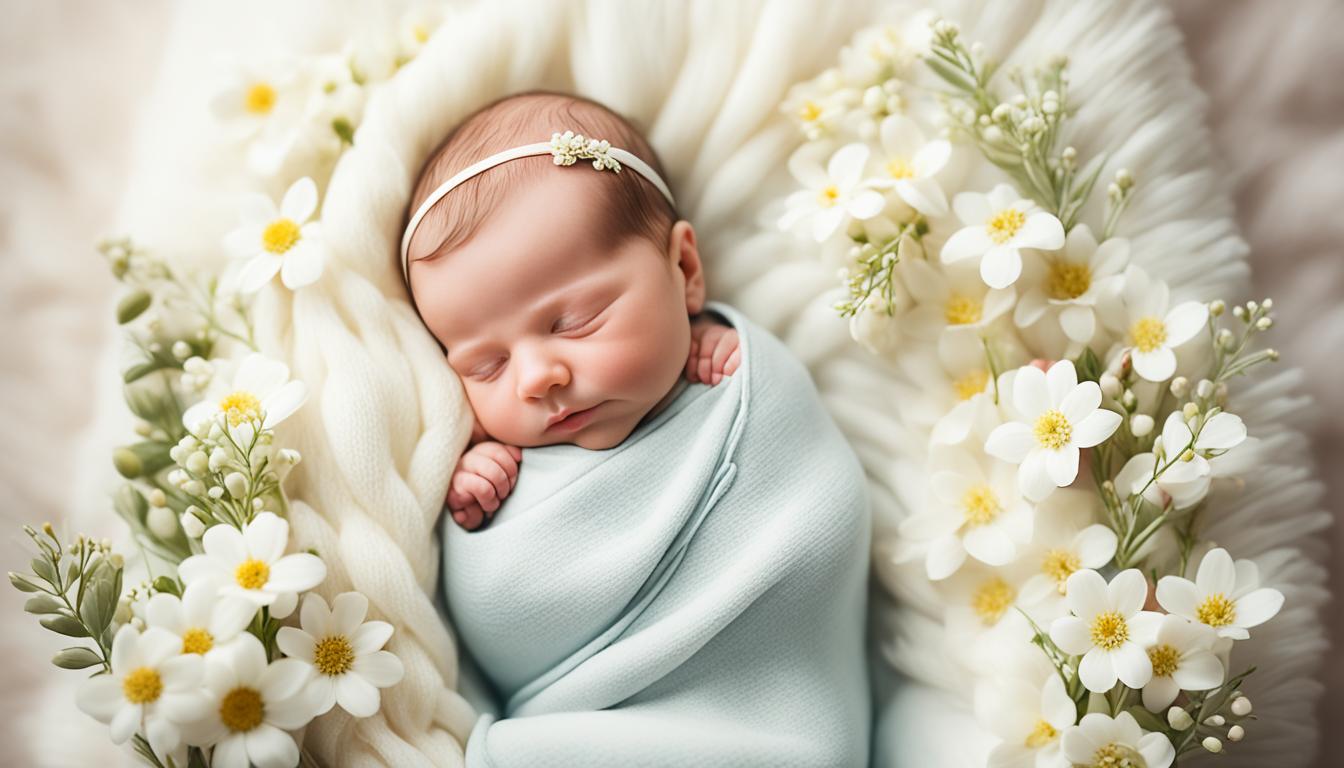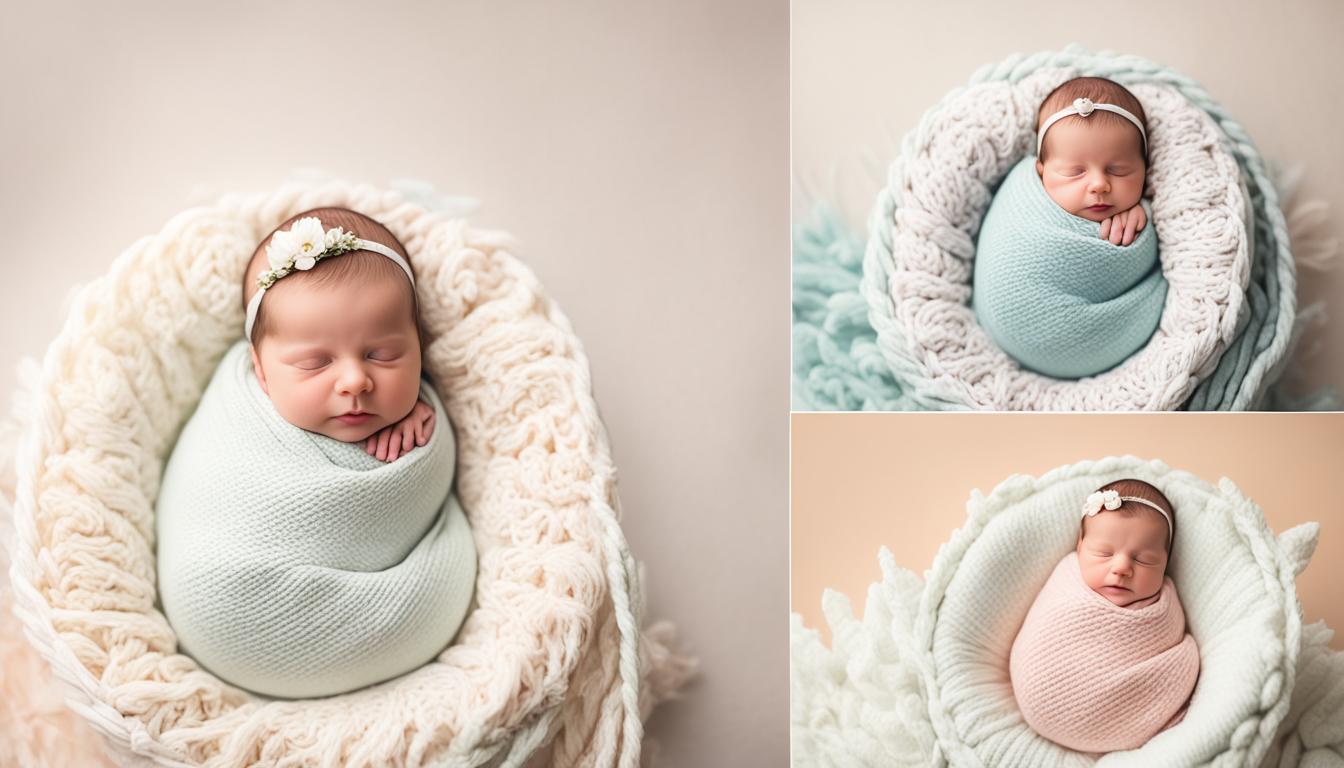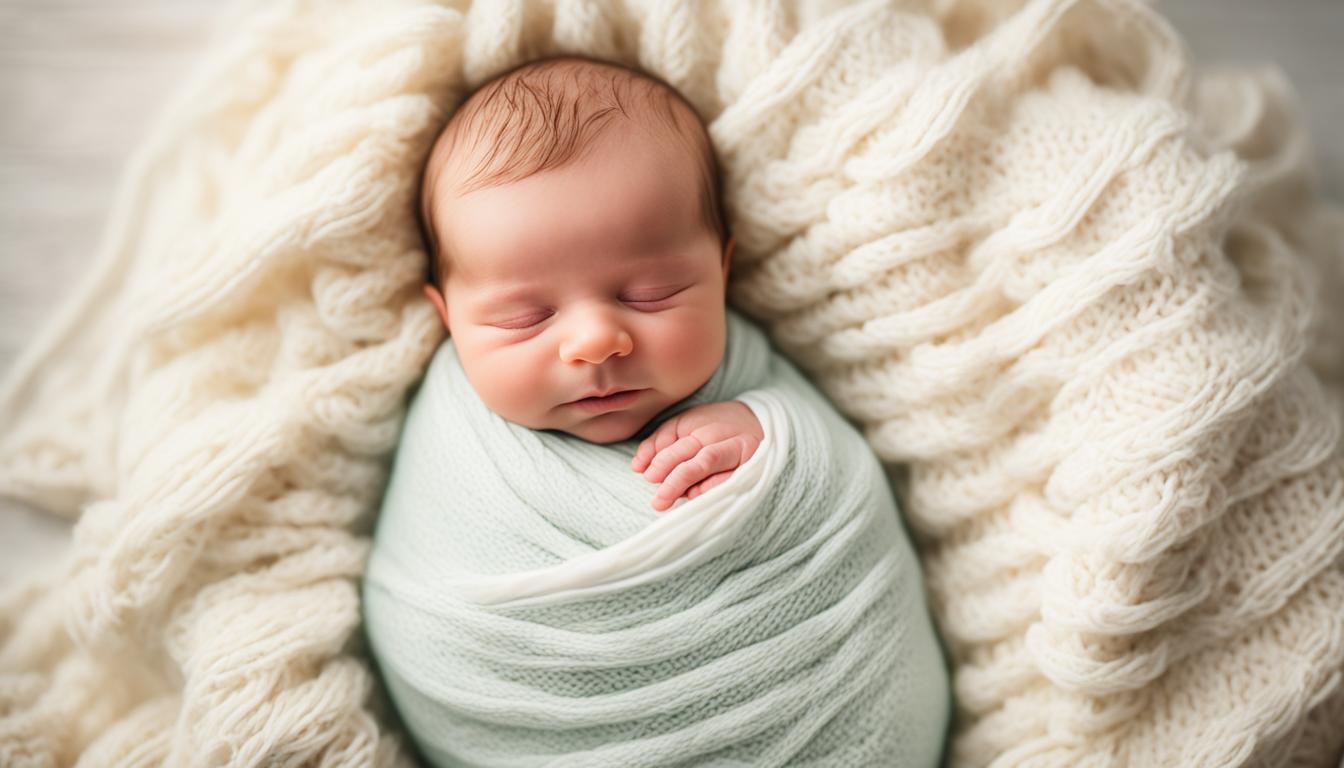Capturing the beauty of a newborn is both incredible and challenging. In this article, we will provide essential tips and tricks for transitioning from newborn to milestone photography. We will cover selecting the right lens, posing techniques, editing tips, and more. Whether you are a proud new parent or an aspiring professional photographer, this article will help you take your skills to the next level.
Key Takeaways:
- Become proficient in newborn photography by mastering essential skills and techniques.
- Select the right lens for capturing the delicate features and expressions of newborns.
- Learn to shoot in manual mode to achieve the best exposures and artistic results.
- Add variety to your newborn portraits by using a zoom lens to capture both close-up details and full scenes.
- Achieve beautiful lighting and soft shadows by utilizing natural light and gentle diffusion techniques.
Planning and Preparation for Newborn Photography
Before picking up your camera, it’s important to plan ahead for a newborn photoshoot. Capturing the beauty and innocence of a new life requires careful consideration and preparation.
Making a Shot List
To ensure you don’t miss any precious moments, start by creating a shot list. Begin with the “safe shots,” such as close-ups of their tiny fingers or the baby sleeping peacefully in their crib. These are classic shots that never go out of style.
Next, get creative and experiment with different angles and lighting. Try capturing the baby’s first moments with their family, such as cuddling with parents or being held by older siblings. These candid shots will help tell a fuller story and create lasting memories.
Remember, newborns grow quickly, so plan to capture a variety of shots that showcase their different stages and milestones. Include a mixture of posed and candid shots to create a well-rounded collection of images.
Experimenting with Angles and Lighting
To add variety to your newborn photoshoot, don’t be afraid to try different angles and lighting techniques. Explore different perspectives, from high above to low on the ground, to capture unique and eye-catching shots.
When it comes to lighting, natural light is your best friend. Position the baby near a window where the soft, diffused light can beautifully illuminate their features. Consider using a white sheet or curtain to further soften and enhance the light.
But don’t limit yourself to natural light alone. Experiment with artificial lighting sources like softboxes or bounce flash to create different moods and effects. Just remember to keep the lighting gentle and flattering, avoiding harsh shadows or strong direct light.
Making the Baby Comfortable
A vital aspect of planning a newborn photoshoot is ensuring the baby’s comfort and safety. The session should take place in a warm and cozy environment to keep the baby content and settled.
Have essential items nearby, such as blankets, diapers, wipes, and feeding supplies. These provisions will help keep the baby comfortable and make for smoother transitions between different shots.
It’s also important to be patient during the photoshoot. Newborns can be unpredictable, so allow extra time for feeding, diaper changes, and soothing the baby as needed. Remember, a happy and relaxed baby makes for better photos.
| Planning Tips | Preparation Tips |
|---|---|
| Make a shot list | Set up a warm and cozy environment |
| Include a mix of safe and creative shots | Have essential items within reach |
| Experiment with different angles and lighting | Allow extra time for feeding and diaper changes |
Choosing the Right Lens for Newborn Photography
When it comes to capturing stunning newborn photos, choosing the right lens is crucial. The lens you use can greatly impact the quality and artistic style of your images. For newborn photography, we recommend using a fast prime lens, such as a 50mm or 85mm lens.
Fast prime lenses are perfect for low-light environments often found during newborn photoshoots. They allow you to capture sharp focus on the subject while achieving a beautifully blurred background, also known as bokeh. To achieve this look, it’s important to use a wide aperture and a small f-number.
Investing in a good prime lens for newborn photography will enhance your ability to capture the delicate features and expressions of newborns. These lenses are known for their sharpness, clarity, and ability to produce stunning images with a shallow depth of field.
If you’re unsure about which lens to choose, here are some key advantages of using a prime lens for newborn photography:
- Wide Aperture: Prime lenses typically have wider maximum apertures, allowing more light to enter the camera and resulting in brighter images and better low-light performance.
- Sharper Image Quality: Prime lenses are designed to provide superior image quality, sharpness, and clarity, which is ideal for capturing the tiny details and expressions of newborns.
- Compact and Lightweight: Prime lenses are often smaller and lighter compared to zoom lenses, making them easier to handle during newborn photoshoots.
- Increased Creativity: Using a prime lens encourages you to move around and explore different angles, enabling you to experiment with composition and create unique and artistic newborn portraits.
Here is a comparison table showcasing the key features of a 50mm and an 85mm prime lens:
| 50mm Prime Lens | 85mm Prime Lens |
|---|---|
| Wide Aperture | Wide Aperture |
| Standard Focal Length | Short Telephoto Focal Length |
| Compact and Lightweight | Compact and Lightweight |
| Versatile for Different Styles and Environments | Flattering Perspective for Portraits |
| Optimal for Close-Up Detail Shots | Great for Capturing Delicate Facial Expressions |
As a newborn photographer, it’s essential to invest in high-quality lenses that suit your style and photography needs. A prime lens with a wide aperture will open up a world of creative possibilities, allowing you to capture the awe-inspiring beauty of newborns in artistic and captivating ways.

Mastering Manual Mode for Newborn Photography
Capturing beautiful and professional-looking newborn photos requires mastering manual mode on your camera. Manual mode gives you full control over the exposure settings, allowing you to achieve the best results. Here are some essential photography techniques to help you master manual mode for newborn photography:
Setting the Aperture
One of the key settings to pay attention to is the aperture. A wide aperture, represented by a low f-number, creates a shallow depth of field, resulting in a dreamy bokeh effect. This helps to isolate the newborn and draw focus to their adorable features. Experiment with different aperture settings to find the perfect balance between sharpness and background blur.
Choosing the Shutter Speed
When photographing newborns, it’s crucial to use a fast enough shutter speed to avoid motion blur. Babies can be quite active, even in their sleep! Aim for a shutter speed of at least 1/125th of a second to freeze any slight movements and ensure crisp images.
Maintaining a Low ISO
To achieve clean and noise-free newborn photos, keep your ISO as low as possible. Higher ISO settings can introduce grain and reduce the overall image quality. Shoot in well-lit environments or use additional lighting to help maintain a low ISO setting.
By mastering manual mode and adjusting the aperture, shutter speed, and ISO, you can create stunning newborn photos that capture the charm and beauty of these precious moments.
Quote: “Manual mode gives you full control over the exposure settings, allowing you to achieve the best results.”
Adding Variety with Zoom Lens in Newborn Portraits
Newborn photography is all about capturing the precious moments and details of a baby’s early days. One way to add variety and enhance your newborn portraits is by using a zoom lens. With a zoom lens, you have the flexibility to capture close-up details as well as wider shots of the entire scene.
Experimenting with different focal lengths allows you to find the perfect shot that showcases the tiny toes, sweet expressions, and adorable features of the newborn. Use the zoom lens to zoom in for those intimate shots that highlight the intricate details, such as the delicate eyelashes or the tiny fingers. These close-up shots add depth and expressiveness to your newborn portraits, capturing the true essence of the newborn.
“A zoom lens gives you the freedom to capture the little details that make each baby unique. It’s like having different lenses in one, allowing you to compose your shots in a way that truly showcases the magic of those first few weeks of life.”
On the other hand, zooming out with the lens can offer a wider perspective, allowing you to capture the newborn in their surroundings. The crib, the nursery, and the loving arms of the parents all contribute to the story of the newborn’s early days. By zooming out, you can capture the full scene and create a collection of photos that document the environment and emotions surrounding the precious newborn.
When using a zoom lens, composition plays a crucial role in creating visually compelling newborn portraits. Pay attention to the placement of the baby within the frame and consider the rule of thirds to create balance and interest. Play with different angles and perspectives to find the most captivating compositions that highlight the beauty of the newborn.
Remember, the key to successful newborn photography is capturing the details and emotions that make each baby unique. A zoom lens allows you to do just that by providing versatility and creative opportunities in capturing both the close-up details and the wider scenes.
| Benefits of Using a Zoom Lens in Newborn Photography | Composition Techniques to Try |
|---|---|
|
|
By leveraging the benefits of a zoom lens and incorporating creative composition techniques, you can elevate your newborn portraits and create images that beautifully capture the essence of those precious first few weeks of life.
Achieving Even Lighting and Soft Shadows in Newborn Photography
Capturing beautiful newborn portraits requires attention to detail, especially when it comes to lighting. In order to create stunning images that showcase the delicate features and innocence of the baby, it’s important to understand lighting techniques that can enhance the overall look and feel of the photographs.
When it comes to newborn photography, natural light is your best friend. It not only produces soft shadows that add depth and dimension to the images but also creates a calming and soothing environment for the baby. Avoid using flash as it can be disruptive and strip the image of its natural texture and tone.
To achieve even lighting and soft shadows, position the newborn near a window where natural light can softly illuminate their face. The direction and intensity of the light will vary depending on the time of day and the angle of the window. Experiment with different positions to find the most flattering light for your subject.
“Natural light not only produces stunning portraits but also creates a calm and soothing environment for the baby.”
One trick to diffuse the light and create a gentle glow is to use a white sheet or curtain. Place it between the window and the newborn to soften the light and reduce harsh shadows. This technique can help create a more ethereal and dreamy look in your photographs.

When positioning the newborn, consider the angle of the light source and how it falls on their face. Side lighting, where the light comes from the side, can create a more dramatic effect and emphasize the contours of the baby’s features. Front lighting, where the light comes directly from the front, can produce a softer and more even look.
Key Points:
- Use natural light for newborn photography to avoid disruptive flash and capture the baby’s natural texture and tone.
- Position the newborn near a window to take advantage of soft, even lighting.
- Experiment with different angles and positions to find the most flattering light for your subject.
- Diffuse the light using a white sheet or curtain to create a gentle glow and reduce harsh shadows.
- Consider the angle of the light source to create different effects and emphasize the baby’s features.
The Joy of Photographing Baby Milestones
Watching your newborn grow and change every day is an incredible experience. As parents, we want to capture each precious moment and milestone along the way. By photographing these special occasions at periodic intervals, we can document their growth and create beautiful keepsakes that will be treasured for a lifetime.
From the moment they enter the world, every little detail is worth capturing. Their tiny fingers and toes, their adorable smiles, and the first time they sit up or take their first steps – these are the milestones that reflect their amazing development and bring immense joy to our hearts.
By embracing milestone photography, we have the opportunity to not only create lasting memories but also observe the subtle changes in our baby’s growth. Through these photographs, we can witness their transformation, from a fragile newborn to a curious explorer, always eager to learn and discover new things.
And let’s not forget to include ourselves in these milestone portraits. By being present in these photographs, we become part of the story. As our children grow older, they will look back at these images and see the love and support we provided, creating a visual narrative of our family’s journey.
Capturing these milestones in photographs is not only about preserving memories; it is about celebrating the joy and wonder of our baby’s remarkable journey. So, grab your camera, embrace the moment, and let’s create beautiful photographs that will forever remind us of the incredible milestones our little ones achieve.
FAQ
How can I plan and prepare for a newborn photoshoot?
Before picking up your camera, make a list of the shots you want to take, starting with the “safe shots” like close-ups of tiny fingers or the baby sleeping in their crib. Then, get creative and experiment with different angles and lighting. Capture the baby’s first moments with their family, such as cuddling with parents or being held by older siblings. The goal is to capture the beauty and innocence of a new life, so take your time and have fun with it.
What lens is recommended for newborn photography?
When it comes to newborn photography, a fast 50mm or 85mm prime lens is recommended. These lenses work well in low-light environments and help capture sharp focus on the subject with a beautifully blurred background. Using a wide aperture and a small f-number is key to achieving this look. A fast standard or telephoto lens is also ideal for capturing the delicate features and expressions of newborns. Investing in a good lens is important for newborn photographers.
How can I master manual mode for newborn photography?
To achieve the best exposures and artistic results in newborn photography, it’s recommended to use Manual mode. Set a wide aperture for that dreamy bokeh effect, but also ensure a fast enough shutter speed to avoid motion blur and camera shake. Keep the ISO as low as possible to minimize noise in the photos. Manual mode allows for more control over the exposure and helps create professional-looking newborn images.
How can I add variety to newborn portraits using a zoom lens?
Using a zoom lens in newborn photography can add variety and capture those close-up details as well as the full scene. Experiment with different focal lengths to find the perfect shot, whether it’s zooming in for a shot of tiny toes or zooming out for a shot of the newborn in their crib. The key is to capture the little details that make the baby unique and create a collection of photos that truly capture the magic of those first few weeks of life.
How can I achieve even lighting and soft shadows in newborn photography?
Capturing beautiful newborn portraits requires attention to detail, especially when it comes to lighting. Flash is not recommended as it can be disruptive and strip the image of its natural texture and tone. Instead, position the newborn near a window where natural light can softly illuminate their face. Using a white sheet or curtain to diffuse the light can create a gentle glow. Natural light not only produces stunning portraits but also creates a calm and soothing environment for the baby.
Why should I photograph my baby milestones?
Watching your newborn grow and change every day is an incredible experience. Photographing their milestones at periodic intervals can help document their growth and create beautiful keepsakes. From their tiny fingers and toes to their first smiles, capturing these moments in photographs allows you to cherish the memories and notice the subtle changes in their development. Including parents in these milestone portraits can also create cherished images that tell the story of your family’s journey.




